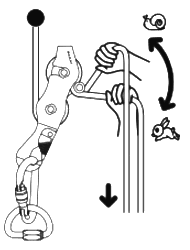Technical Details
I acquired my Kailas Alfa from Kailas in 2021.
My Kailas Alfa is 197 mm. tall, 60 mm. wide, 34 mm. thick, and weighs 281 g.
The two side plates are stamped from 2.8 mm. aluminum.
The lower ends of the side plates
are bent to converge at the attachment point. The attachment point on the fixed side plate is a 25 mm. high by 13 mm. wide hole located along the line connecting the two bollard centers. A similar hole on the pivoting side plate has been
cut open on the narrow side, so the opening resembles a hook.
The opening of the hook is covered by a spring loaded, stamped
steel, sheet metal gate riveted to the pivoting side plate.
One plate
pivots to allow threading the rope. The bollards are turned aluminum with two rectangular projections
that engage square holes in the fixed side plate to keep them from rotating. The bollards
are bolted to the fixed side plate with
7 mm. bolts hex round-head cap screws. Shoulder nuts lock the bollards in place and
also retain the pivoting side plate. The pivoting side plate pivots
on the lower shoulder nut and has a slot to allow clearing the
upper nut. Unlike the Petzl Bobbins,
both bollards are identical with U-grooves. These are 8.4 mm. wide and 4.3 mm. deep. The bollards are 42 mm. in diameter and 15.8 mm. thick, excluding the projections. The inner diameter of the rope groove is 33.5 mm.
The stainless steel auxiliary rod at the top is riveted to the fixed plate. The rod is 15 mm. in diameter and extends 21 mm. from the fixed plate. The central 15.6 mm. of this rod is reduced to 8 mm. diameter. A 7 mm. reduced diameter
end of the steel rod passes through the upper end of the fixed
side plate and riveted in place.
The upper end of the side plates are offset to place the auxiliary
bollard closer to the "up" side of the main rope. The
pivoting side plate is notched to clear the auxiliary bollard
as well as the upper main bollard nut.
The Kailas has a patented "decelerator" consisting of a pivoting stainless steel arm and auxiliary bollard. The arm pivots on the bolt holding the lower main bollard. The decelerator bollard is bolted to the arm with a machine screw with a hex countersunk head. This bollard extends 17 mm. from the arm and is 15 mm. in diameter, with a rope groove formed by a 9 mm. wide section tapering down to a 5.5 mm. wide, 9 mm. diameter section.
The pivoting plate is stamped with "KAILAS," a rigging illustration, " ROPE 8≤Ø≤12," and an icon combining a caution sign and a book-with-an-"i" icon. The fixed plate is stamped with "KAILAS." The back of the decelerator arm is stamped with "PAT. KAILAS" and "ALFA." The main bollard screw heads and decelerator bollard screw head are stamped with "012.9" and "YFS."
The Kailas is a nice bobbin made in China.
 The bollard projections preventing rotation are similar to those on the Climbing Technology Acles DX and Repetto Spider, but the Kailas only has two, so the bobbins can only be rotated 180° when worn. This is not really a problem and most bobbins only allow 180° rotation, but I prefer the 90° option that four projections would provide. Like the Climbing Technology Acles DX and Repetto Spider, the upper and lower bobbins are interchangeable; a feature that many bobbins such as the Petzl Bobbins lack.
The bollard projections preventing rotation are similar to those on the Climbing Technology Acles DX and Repetto Spider, but the Kailas only has two, so the bobbins can only be rotated 180° when worn. This is not really a problem and most bobbins only allow 180° rotation, but I prefer the 90° option that four projections would provide. Like the Climbing Technology Acles DX and Repetto Spider, the upper and lower bobbins are interchangeable; a feature that many bobbins such as the Petzl Bobbins lack.
Kailas’ patented decelerator is an interesting concept. They claim that it effectively increases friction and allows easy and quick stopping, and that it allows one to easily stop and hold their position on rope. I find that it certainly helps, but the stopped position does not provide a firm lock - tension on the trailing line is still necessary. Curiously, the Kailas web site says, "ALFA descender with its patented decelerator which effectively increases rope friction, makes descending faster and safer" which must be a translation error, since increasing friction cannot make descending faster.
In any case, my interest in the decelerator is not in its ability to provide a better stop position, but on the possibility that it could eliminate the need for a safety carabiner (or equivalent) is intriguing. The rope groove on the decelerator is not deep enough to ensure that the rope cannot slip off, but perhaps a hook (possibly with a latch) could be incorporated.

For far more content, use a larger monitor and a full-width window.
Hundreds of cell phone users complained and asked me to for a simpler, mobile friendly site. In particular, they wanted me to limit each page to a small number of pictures and minimize my use of text. This new site provides what they asked for.

